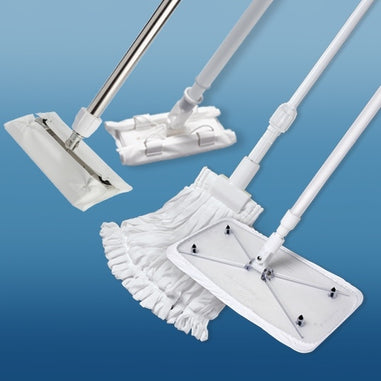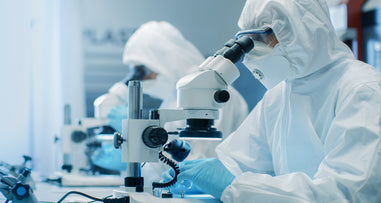- No products in the cart.
ESD and Electronic Failure
The medical industry is highly dependent on properly functioning technology. Electrostatic discharge (ESD) is an ongoing threat to the integrity and safety of medical devices. Larger electronic devices and panel displays are susceptible to static failures as well as smaller devices that must be manufactured to precise dimensions such as catheters, syringes, and fluid management tubing.
Static control is crucial in medical device manufacturing, from the first microchip that is soldered, to packaging, to customer use. ESD events can cause medical device part or product failure, resulting in lost time and money, while undetected damage can lead to patient harm in care settings. In addition, medical device manufacturers should consider how ESD events occur when equipment is used in the field, where static conditions reach levels above carefully controlled lab settings or if relative humidity (RH) exceeds recommended limits.

Lab Pro has a plethora of static control supplies to help protect your medical and life sciences device manufacturing cleanroom with ANSI/ESDS20.20 compliant garments, instruments, surface coatings, and cleaning tools.
Static and Safety
Electrostatic discharge can happen when two charges materials contact, short circuit, or experience dielectric breakdown.
- Tribocharging: Materials that become electrically charged when they were in contact with each other and then separate.
- Electrostatic induction: Static electricity is generated when an object is brought near an electrically charged object and charges are redistributed. One of the materials has an excess of positive charges (+) while the other material has an excess of negative (-) charges.
In 2016 the Institute of Electrical and Electronics Engineers (IEEE) reported that electronics with microelectronics are particularly vulnerable to damage by ESD, including infusion pumps, chemistry analyzers, neurostimulators, heart assistant devices, and cochlear implants. Root causes of failure include premature battery depletion and unresponsive (frozen) keypads and displays, caused by short circuits in the integrated circuit (IC), static charge buildup caused by improper grounding systems, and faulty ESD protection circuitry.1 Device failure can result in recoverable or nonrecoverable damage, incorrect results, and even death. Low RH correlated with higher rate of equipment malfunction.
Steps to Control Static in ESD Cleanrooms
- Designate an Electrostatic Discharge Protected Area (EPA).
- Keep humidity at 50-60% and temperature at 70-75°C (21-24°C).
- Keep filtration systems clean.
- Use cleanroom tacky mats to remove dust from footwear before entering.
- Ensure that ESD workstations and tools are static dissipative, particularly for static sensitive electronic components.
- Convert your standard bumpers, bins, tools, and surfaces to ESDsafe, ANSI/ESDS20.20 compliant surfaces with Techspray Licron crystal static-dissipative urethane coatings. Available in spray, 1-gallon, 5-gallon, and 54-gallon quantities.
- Order ESD-safe binocular and ringlight accessories for you microscopes.
- Make Sure that conductive parts and pieces are grounded.
- Ground medical cleanroom device employees with Desco’s Trustat® 04548 ERGOclean wrist strap with/4MM snap and 6' CORD, BLACK. This product meets ANSI/ESD S1.1 1-5 lb. breakaway requirement, and the coil cord has a 1 Megohm limiting resistor.
- Check for ESD with a multimeter.
- Keep surfaces are free of dust and charged particles (neutralized).
- Control static generated contamination off of monitors with Screen Prep or Techspray Screen & Keyboard Cleaner
- Polish, clean, and remove static charges all in one step with Static Free Plast-N-Glas.
- Clean flux and other residues off of ESD-safe mats and tabletops with Techspray Zero Charge Mat & Tabletop Cleaner.
- Penetrate and lifts light oils, fingerprints and flux residues from surfaces while providing static dissipative protection with Static Free Mat & Benchtop Reconditioner spray or wipes.
- Dry wipe dry ESDsensitive components and boards with Techspray Techclean Anti-Static Wipes.
- Dissipate 99% of 5,000 volts charge in less than 2 seconds with Coventry ESD static swabs.
- Clean dust particles and solder debris with Excelta ESD brushes.
- Vacuum particle safely with Excelta ESD-safe pen-vacs®.
- Keep highly charging materials away from ESD sensitive electronics to prevent charge build-up on them.
- Synthetic surfaces containing wax, plastic, nylon, fiberglass, or foam are potential sources of static electricity.
- Use LED light source with improved resistance to vibration & shock, ESD Immunity (Heavy Industrial).
- Prevent Electrical Overstress (EOS) and overheating during soldering.
- Optimize heat transfer during the desoldering process with Chemtronics Soder-Wick® rosin flux desoldering braid.
- Plato® flux needle dispensers are precise ways to clean flux residues and come in static dissipative versions.
- Re-tin oxidized soldering tips with Plato® Tip-Tin.
- Use ESD-safe lead cutters for hard to reach areas in electronic assemblies.
- Diagnose defective components.
- Increases visibility of cold solder joints, cracks in printed circuit boards and oxidized junctions with Techspray Freezer
- Techspray Anti-Static Freezer contains additives that avoids static build-up, critical when working with ESD-sensitive components.
- Don anti-static PPE
- Use ESD safe tools
- Dispense adhesives to electronics assemblies and apply lubricants to small moving parts with high precision miniature spatulas.
- Apply ESD-safe HDPE Durastatic™ liquids into the top dish for static sensitive printed circuitry.
- Use conductive or dissipative ESD tweezers.
Importance of ESD Protection
Preventing ESD in the medical device manufacturing arena at all stages of production is compulsory for cost and quality. More importantly, preventing defects/incidents due to static buildup/discharge safeguards and streamlines patient care. Lab Pro has the equipment you need to keep static from clinging to the specialty electronic and microelectronics you proudly produce.
Note: These products and chemicals are meant to be used for research, industrial work, cleaning or disinfecting and should always be stored out of the reach of young children or infants.
For over 40 years, Lab Pro Inc. has been committed to delivering the highest quality chemicals, ESD protection, laboratory and cleanroom supplies to medical device and electronic manufacturing laboratories worldwide. To learn more, visit the biggest Lab Supply showroom in California, or contact us online or at 888-452-2776.
References
- Kohani, Mehdi & Pecht, Michael. (2017). Malfunctions of Medical Devices Due to Electrostatic Occurrences. IEEE Access. PP. 1-1. 10.1109/ACCESS.2017.2782088.



















































